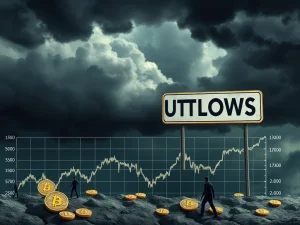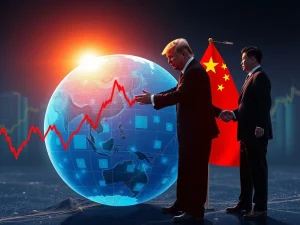Alarming Buffett Indicator Soars Past 212%: Is a Market Correction Imminent?

For many in the cryptocurrency space, the traditional stock market often feels like a distant, albeit influential, cousin. Yet, when a critical economic indicator flashes a warning light as bright as the latest Buffett Indicator reading, it’s a signal that demands attention from every investor, regardless of their preferred asset class. In July 2025, the U.S. stock market reached a valuation level that has financial veterans scratching their heads and history buffs recalling past market upheavals. The Buffett Indicator, a metric closely watched by none other than Warren Buffett himself, has soared past an unprecedented 212% of GDP, marking a new record high. This surge raises crucial questions about the sustainability of current market valuations and what it could mean for the broader financial landscape, including the volatile world of digital assets.
What is the Buffett Indicator, and Why Does it Matter?
The Buffett Indicator, formally known as the total stock market capitalization to Gross Domestic Product (GDP) ratio, is a valuation metric favored by legendary investor Warren Buffett. It’s calculated by taking the total market value of all publicly traded stocks in a country (often using the Wilshire 5000 Total Market Index for the U.S.) and dividing it by the nation’s latest GDP figure. Warren Buffett famously described it in a 2001 Fortune Magazine interview as “probably the best single measure of where valuations stand at any given moment.”
Historically, a ratio around 75% to 90% is considered fair value. When the indicator approaches 200%, Buffett himself warned it signals “dangerous overvaluation.” The logic is simple: if the market’s value far exceeds the country’s total economic output, it suggests that asset prices are inflated beyond fundamental economic realities. The current reading, surpassing 212%, not only exceeds the peaks of the Dot-Com Bubble but also the 2008 Financial Crisis, placing us in truly uncharted territory. This makes it a crucial economic indicator for assessing market health.
Unprecedented Market Valuations: A Look at the Numbers
The July 2025 data paints a stark picture: the U.S. stock market’s capitalization is now more than double the nation’s GDP. This astonishing figure is primarily driven by the continued ascent of mainstream indices:
- S&P 500: Closed at 6,388 on July 25, 2025, up 0.9% from its previous session.
- Nasdaq Composite: Hit a third record close of the week, surpassing 21,000.
- Dow Jones Industrial Average: Gained 0.5%, nearing its December 2024 record.
What’s fueling this climb, even as the Buffett Indicator screams caution? A significant factor has been robust corporate performance, with over 82% of S&P 500 companies reporting earnings that exceeded expectations. Analysts point to “favorable fundamentals” like stable inflation and range-bound interest rates as underpinning this bull market. However, the sheer scale of these market valuations is unprecedented, leading many to wonder if we are witnessing the formation of a massive stock market bubble.
Warren Buffett’s Moves: A Precedent for Caution?
It’s one thing for an indicator named after him to flash red, but what is Warren Buffett’s Berkshire Hathaway actually doing? Interestingly, Berkshire Hathaway has been systematically divesting from U.S. equities since 2020. This strategic shift is widely interpreted as a practical application of Buffett’s own cautionary advice regarding high valuations.
In Q1 2025 alone, the conglomerate made significant moves:
- Sold nearly $3.5 billion in financial sector holdings.
- Liquidated its entire stake in Citigroup.
- Reduced significant portions of its holdings in Bank of America and Capital One.
- Exited positions in Charter Communications, DaVita, T-Mobile, and Liberty Media’s Formula One Group.
These actions reflect a broader strategy to reduce exposure to equities amidst rising valuations, aligning with the signal from the Buffett Indicator. While Berkshire’s moves are not a direct prediction, they certainly offer a powerful example of caution from one of the world’s most successful long-term investors, particularly when considering the sustainability of current asset prices.
Is This a Stock Market Bubble? The Role of Speculative Trading
The debate rages: are we in a stock market bubble? Beyond fundamental earnings, a significant driver of the current surge in asset prices has been speculative trading. Goldman Sachs’ Speculative Trading Indicator, which tracks activity in unprofitable stocks and those with high Enterprise Value/Sales multiples, has reached record levels since 2020-2021. While still below the absolute peaks of the dot-com bubble and the 2020 pandemic rally, the metric highlights a growing appetite for risk, particularly in sectors dominated by tech giants and, notably, digital asset firms.
This speculative fervor, combined with the record-breaking Buffett Indicator, creates a volatile mix. The rapid appreciation of certain assets, sometimes detached from underlying profitability, is a hallmark of speculative periods. While optimism can fuel growth, excessive speculation can lead to sharp corrections when sentiment shifts or external factors intervene.
Navigating Macroeconomic Uncertainty: Fed Policy and Political Headwinds
The Federal Reserve finds itself in a precarious position, attempting to balance inflation control with economic growth. While a rate cut in September 2025 is now priced at 60%, several factors complicate this delicate act:
- Inflationary Pressures: Trump-era tariffs continue to exert upward pressure on prices. UBS, for instance, highlighted a 3.6% price increase for consumer appliances due to these tariffs, potentially delaying rate cuts beyond December.
- Monetary Policy Tightrope: The Fed must avoid both stifling growth with overly restrictive policies and reigniting inflation with premature cuts.
Adding to the complexity are political developments. A proposed corporate tax cut under Donald Trump’s legislative agenda aims to boost capital expenditures, with Piper Sandler forecasting a 3% real GDP growth for 2026 under this scenario. While seemingly positive, such measures introduce new economic variables, as growth from capital spending typically differs in magnitude and timing from housing-driven expansions. These factors collectively contribute to the uncertainty surrounding the sustainability of current asset prices.
What Does This Mean for Investors and Asset Prices?
The record-high Buffett Indicator serves as a significant red flag, underscoring a widening gap between asset prices and economic fundamentals. While central bank liquidity and speculative flows have sustained these elevated valuations, the future remains uncertain. Advisorpedia emphasizes that while the indicator signals elevated risks, actual market outcomes depend on broader factors, including earnings trends and macroeconomic stability. Tesla’s 8.2% drop following weak earnings underscored the fragility of current conditions, reminding investors that even market darlings are not immune to reality.
For cryptocurrency investors, this traditional market volatility is particularly relevant. While often seen as an uncorrelated asset, crypto markets can be affected by broader risk-off sentiment. If a significant correction occurs in the traditional stock market, it could trigger capital reallocation, potentially impacting digital asset valuations as well. Diversification and careful risk management become paramount in such an environment.
The interplay of policy decisions, corporate performance, and political developments will ultimately determine whether this period of extreme overvaluation persists or corrects. For now, investors remain divided, navigating a landscape where optimism and caution coexist. The question isn’t just whether the market will correct, but when, and how severely. Prudence and a clear understanding of your risk tolerance are more important than ever.
Frequently Asked Questions (FAQs)
Q1: What is the Buffett Indicator, and how is it calculated?
The Buffett Indicator measures the total market capitalization of all publicly traded U.S. stocks (typically using the Wilshire 5000 Total Market Index) relative to the country’s Gross Domestic Product (GDP). It’s calculated as (Total Market Cap / GDP) * 100%.
Q2: What does a high Buffett Indicator reading like 212% signify?
A reading of 212% or higher indicates significant overvaluation in the stock market. Warren Buffett himself has warned that ratios approaching 200% signal dangerous overvaluation, suggesting that asset prices are inflated beyond underlying economic fundamentals.
Q3: How does the current market situation compare to past bubbles?
The current Buffett Indicator reading of over 212% surpasses the peaks seen during both the Dot-Com Bubble (around 150-160%) and the 2008 Financial Crisis (around 100-110%). This suggests the market is in an unprecedented state of valuation.
Q4: Why are mainstream indices still climbing despite the warning from the Buffett Indicator?
Mainstream indices continue to climb due to factors such as robust corporate earnings exceeding expectations, stable inflation, range-bound interest rates, and significant speculative trading activity, particularly in high-growth sectors. These factors contribute to the perceived “favorable fundamentals” driving the bull market.
Q5: What are the potential implications for cryptocurrency investors?
While often seen as a distinct asset class, cryptocurrency markets can be influenced by broader traditional market sentiment. A significant correction in the stock market, signaled by the high Buffett Indicator, could lead to a “risk-off” environment, potentially impacting digital asset valuations as investors reallocate capital or seek safer havens.
Q6: What actions has Berkshire Hathaway taken in response to high valuations?
Since 2020, Berkshire Hathaway has been divesting from U.S. equities, particularly in the financial sector. In Q1 2025 alone, it sold billions in holdings, including its full stake in Citigroup and significant portions of Bank of America and Capital One, reflecting a strategy to reduce exposure to overvalued equities.









